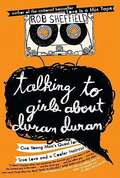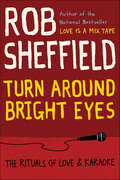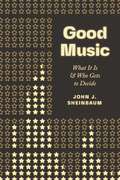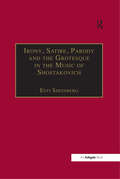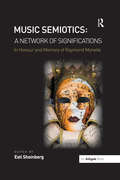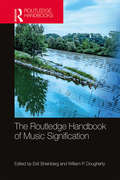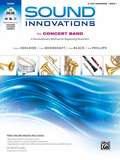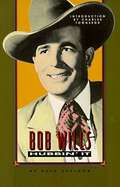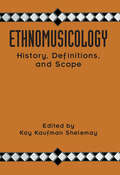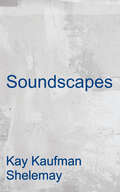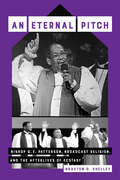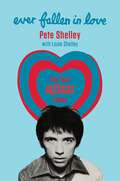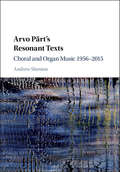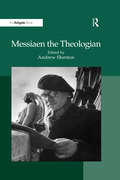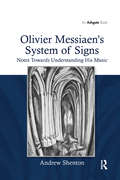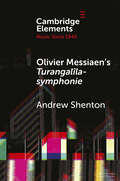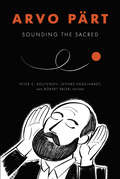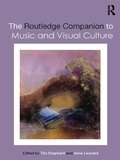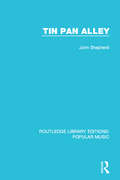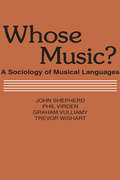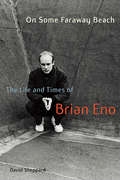- Table View
- List View
Talking to Girls About Duran Duran
by Rob SheffieldFrom the bestselling author of Love Is a Mix Tape and Turn Around Bright Eyes, "a funny, insightful look at the sublime torture of adolescence". -Entertainment Weekly The 1980s meant MTV and John Hughes movies, big dreams and bigger shoulder pads, and millions of teen girls who nursed crushes on the members of Duran Duran. As a solitary teenager stranded in the suburbs, Rob Sheffield had a lot to learn about women, love, music, and himself. And he was sure his radio had all the answers. As evidenced by the bestselling sales of Sheffield's first book, Love Is a Mix Tape, the connection between music and memory strikes a chord with readers. Talking to Girls About Duran Duran strikes that chord all over again, and is a pitch-perfect trip through '80s music-from Bowie to Bobby Brown, from hair metal to hip-hop. But this book is not just about music. It's about growing up and how every song is a snapshot of a moment that you'll remember the rest of your life. .
Turn Around Bright Eyes: The Rituals of Love & Karaoke
by Rob SheffieldOnce upon a time I was falling apart. Now I'm always falling in love.Pick up the microphone.When Rob Sheffield moved to New York City in the summer of 2001, he was a young widower trying to start a new life in a new town. Behind, in the past, was his life as a happily married rock critic, with a wife he adored, and a massive collection of mix tapes that captured their life together. And then, in a flash, all he had left were the tapes.Beyoncé , Bowie, Bon Jovi, Benatar . . .One night, some friends dragged him to a karaoke bar in the West Village. A night out was a rare occasion for Rob back then.Turn aroundSomehow, that night in a karaoke bar turned into many nights, in many karaoke bars. Karaoke became a way out, a way to escape the past, a way to be someone else if only for the span of a three-minute song. Discovering the sublime ridiculousness of karaoke, despite the fact that he couldn't carry a tune, he began to find his voice.Turn aroundAnd then the unexpected happened. A voice on the radio got Rob's attention. The voice came attached to a woman who was unlike anyone he'd ever met before. A woman who could name every constellation in the sky, and every Depeche Mode B side. A woman who could belt out a mean Bonnie Tyler.Bright EyesTurn Around Bright Eyes is an emotional journey of hilarity and heartbreak with a karaoke soundtrack. It's a story about finding the courage to move on, clearing your throat, and letting it rip. It's a story about navi- gating your way through adult romance. And it's a story about how songs get tangled up in our deepest emotions, evoking memories of the past while inspiring hope for the future.
Let's Go to The Grand!: 100 Years of Entertainment at London's Grand Theatre
by Sheila M.F. Johnston"A fascinating history of a wonderful old theatre." - Hume Cronyn In September of 1901 London’s New Grand Opera House flung open its doors. Boasting a beautiful interior design, and with the most modern stage equipment available, the theatre was large enough to accommodate over 1,700 patrons and the largest touring shows of the time. With impresario Ambrose J. Small at the helm, a new era in theatrical entertainment began. Throughout the next hundred years, the Grand Theatre hosted everything from stock companies to minstrel shows, from vaudeville to star-studded productions. The celebrated amateur theatre company, London Little Theatre, made The Grand its home for decades. As Canadian theatre came into its own in the 1970s, The Grand embraced professional theatre status. Throughout all these changes The Grand has remained London’s "Grand Old Lady of Richmond Street." Legendary performers from the past, including the Marks Brothers, Anna Pavlova and John Gielgud have graced its vast stage, as have such contemporary stage stars as Hume Cronyn, William Hutt and Martha Henry. This extensively researched book, lavishly illustrated, lovingly documents the life of The Grand. Theatre stories from every decade of The Grand’s colourful life abound throughout. To read this book is to come to know London’s Grand Theatre in all its architectural splendour and its legacy in Canadian theatre history.
Good Music: What It Is & Who Gets to Decide
by John J. SheinbaumOver the past two centuries Western culture has largely valorized a particular kind of “good” music—highly serious, wondrously deep, stylistically authentic, heroically created, and strikingly original—and, at the same time, has marginalized music that does not live up to those ideals. In Good Music, John J. Sheinbaum explores these traditional models for valuing music. By engaging examples such as Handel oratorios, Beethoven and Mahler symphonies, jazz improvisations, Bruce Springsteen, and prog rock, he argues that metaphors of perfection do justice to neither the perceived strengths nor the assumed weaknesses of the music in question. Instead, he proposes an alternative model of appreciation where abstract notions of virtue need not dictate our understanding. Good music can, with pride, be playful rather than serious, diverse rather than unified, engaging to both body and mind, in dialogue with manifold styles and genres, and collaborative to the core. We can widen the scope of what music we value and reconsider the conventional rituals surrounding it, while retaining the joys of making music, listening closely, and caring passionately.
Irony, Satire, Parody and the Grotesque in the Music of Shostakovich: A Theory of Musical Incongruities
by Esti SheinbergThe music of Shostakovich has been at the centre of interest of both the general public and dedicated scholars throughout the last twenty years. Most of the relevant literature, however, is of a biographical nature. The focus of this book is musical irony. It offers new methodologies for the semiotic analysis of music, and inspects the ironical messages in Shostakovich‘s music independently of political and biographical bias. Its approach to music is interdisciplinary, comparing musical devices with the artistic principles and literary analyses of satire, irony, parody and the grotesque. Each one of these is firstly inspected and defined as a separate subject, independent of music. The results of these inspections are subsequently applied to music, firstly music in general and then more specifically to the music of Shostakovich. The composer‘s cultural and historical milieux are taken into account and, where relevant, inspected and analysed separately before their application to the music.
Music Semiotics: In Honour and Memory of Raymond Monelle
by Esti SheinbergUnited in their indebtedness to the scholarship of Raymond Monelle, an international group of contributors, including leading authorities on music and culture, come together in this state of the art volume to investigate different ways in which music signifies. Music semiotics asks what music signifies as well as how the signification process takes place. Looking at the nature of musical texts and music's narrativity, a number of the essays in this collection delve into the relationship between music and philosophy, literature, poetry, folk traditions and the theatre, with opera a genre that particularly lends itself to this mode of investigation. Other contributions look at theories of musical markedness, metaphor and irony, using examples and specific musical texts to serve as case studies to validate their theoretical approaches. Musical works discussed include those by Haydn, Mozart, Beethoven, Schumann, Wagner, Stravinsky, Bart Xenakis, Kutavicius and John Adams, offering stimulating discussions of music that attest to its beauty as much as to its intellectual challenge. Taking Monelle's writing as a model, the contributions adhere to a method of logical argumentation presented in a civilized and respectful way, even - and particularly - when controversial issues are at stake, keeping in mind that contemplating the significance of music is a way to contemplate life itself.
The Routledge Handbook of Music Signification
by Esti Sheinberg William P. DoughertyThe Routledge Handbook of Music Signification captures the richness and complexity of the field, presenting 30 essays by recognized international experts that reflect current interdisciplinary and cross-disciplinary approaches to the subject. Examinations of music signification have been an essential component in thinking about music for millennia, but it is only in the last few decades that music signification has been established as an independent area of study. During this time, the field has grown exponentially, incorporating a vast array of methodologies that seek to ground how music means and to explore what it may mean. Research in music signification typically embraces concepts and practices imported from semiotics, literary criticism, linguistics, the visual arts, philosophy, sociology, history, and psychology, among others. By bringing together such approaches in transparent groupings that reflect the various contexts in which music is created and experienced, and by encouraging critical dialogues, this volume provides an authoritative survey of the discipline and a significant advance in inquiries into music signification. This book addresses a wide array of readers, from scholars who specialize in this and related areas, to the general reader who is curious to learn more about the ways in which music makes sense.
Sound Innovations for Concert Band, E-Flat Alto Saxophone, Book 1: A Revolutionary Method For Beginning Musicians (e-flat Alto Saxophone), Book, CD and DVD (Sound Innovations for Concert Band Ser. #1)
by Robert Sheldon Peter Boonshaft Dave Black Bob PhillipsNIMAC-sourced textbook
Bob Wills: Hubbin' It
by Ruth Sheldon Charles R. TownsendUnavailable for decades, this pioneering biography of the King of Western Swing returns to print in a handsome new edition with index and a new critical introduction. Few figures in country music's history have left as distinctive and lasting an impression as Bob Wills (1905-1975). An expert fiddler and a magnetic showman, Wills popularized a style of Southwestern dance music known as western swing, a rhythmic hybrid of Texas fiddle music, blues, and big band swing that set dance halls alight across the Southwest in the thirties and forties. Despite his passing, his legacy has been carried forward in the music of such modern stars as Merle Haggard and George Strait. In 1938, when Wills was thirty-three and nearing the height of his fame, journalist Ruth Sheldon chronicled the rags-to-riches rise of this talented musician, showing remarkable foresight in her choice of subject. Working with the complete cooperation of Wills, Sheldon produced a biography that fully captures the ebullient personality of Wills and reflects the bandleader's vision of himself. Noted country music historian Bill C. Malone has praised this book as a "pioneering biography," a landmark in the recording of country music history. Now restored to print for the first time since its initial 1938 publication, Hubbin' It provides a fascinating window into the daily life of a working musician during the Depression. It is a rich source of historical detail on the life of one of America's great musical innovators. Distributed for the Country Music Foundation Press.
Ethnomusicology: History, Definitions, and Scope: A Core Collection of Scholarly Articles
by Kay Kaufman ShelemayFirst Published in 1992. Routledge is an imprint of Taylor & Francis, an informa company.
Soundscapes: Exploring Music in a Changing World
by Kay Kaufman ShelemayMusic doesn’t stop at the border, and neither should your textbook. This text gives students a global sense of music and its significance across cultures by introducing them to a diverse repertoire and developing listening skills applicable to all music. An accessible three-part model for listening―sound, setting, and significance―facilitates comparisons of various musical styles and meanings, and with Total Access, Soundscapes provides the digital resources students need to discover new music in a digitally connected world.
Who Is The Greatest: Elvis Or The Beatles
by Mike Shellans Bill SlaterMike Shellans and Bill Slater have come together in their life-long interests in Elvis and The Beatles to create the first comparison of these influential Pop icons. Who is the Greatest: Elvis or The Beatles? is a relevant and engaging textbook for a Music History or Popular Culture survey course. It provides a wealth of information and context about the music, lives, and careers of Elvis and The Beatles.
An Eternal Pitch: Bishop G. E. Patterson, Broadcast Religion, and the Afterlives of Ecstasy (Phono: Black Music and the Global Imagination #2)
by Braxton D. ShelleyAn Eternal Pitch examines the homiletic life and afterlife of Bishop G. E. Patterson, the dynamic spiritual leader of the Church of God in Christ from 2000 to 2007. Although Patterson died in 2007, his voice remains a staple of radio and television broadcast, and his sermons have taken on a life of their own online, where myriad YouTube, Facebook, Instagram, and TikTok users enact innovative forms of religious broadcasting. Their preoccupation with Patterson’s "Afterliveness" punctuates the significance of Patterson’s preoccupation with musical repetition: across the decades of Patterson’s ministry, a set of musical gestures recur as sonic channels, bringing an individual sermon into contact with scripture’s eternal transmission.
Ever Fallen in Love: The Lost Buzzcocks Tapes
by Pete Shelley Louie Shelley***'Lots of great stories... A fascinating insight.'-JOHN MAHER, Buzzcocks'Perfectly executed, highly detailed, incredibly interesting.'-HENRY ROLLINS, Black Flag'Pete and Buzzcocks were there right from the beginning.'-BERNARD SUMNER, Joy Division, New Order When Pete Shelley, lead singer of legendary punk band Buzzcocks, passed away in 2018 we lost the chance to hear one of music's brightest stars tell his story.Or so it seemed.Now, recordings have surfaced of a series of remarkable interviews in which Pete tells the story of his life, his band and his place at the beating heart of the punk explosion in fascinating detail.Recorded over a series of late-night calls with a close friend, the tapes hear Pete talk song-by-song through Buzzcocks releases to reveal the personal memories behind the music and the inspiration for masterpieces such as 'Ever Fallen in Love (With Someone You Shouldn't've)' and 'What Do I Get?'.Published for the first time and with the blessing of Pete's estate, Ever Fallen In Love: The Lost Buzzcocks Tapes is a tribute to a founding member of punk and a chance to hear one of music's true visionaries tell his own story at last.'A true gentleman and a great artist and songwriter.'-PETER HOOK, Joy Division, New Order 'Shot through with self-doubt and mild regret, Pete Shelley's lovesick pop classics have a bittersweet charm that will forever speak to the young romantic'-JOHN COOPER CLARKE'Buzzcocks were the blue touchpaper for my love of music. Pure pop met punk and the result was perfection.'-TIM BURGESS, The Charlatans
Ever Fallen in Love: The Lost Buzzcocks Tapes
by Pete Shelley Louie Shelley***'Lots of great stories... A fascinating insight.'-JOHN MAHER, Buzzcocks'Perfectly executed, highly detailed, incredibly interesting.'-HENRY ROLLINS, Black Flag'Pete and Buzzcocks were there right from the beginning.'-BERNARD SUMNER, Joy Division, New Order When Pete Shelley, lead singer of legendary punk band Buzzcocks, passed away in 2018 we lost the chance to hear one of music's brightest stars tell his story.Or so it seemed.Now, recordings have surfaced of a series of remarkable interviews in which Pete tells the story of his life, his band and his place at the beating heart of the punk explosion in fascinating detail.Recorded over a series of late-night calls with a close friend, the tapes hear Pete talk song-by-song through Buzzcocks releases to reveal the personal memories behind the music and the inspiration for masterpieces such as 'Ever Fallen in Love (With Someone You Shouldn't've)' and 'What Do I Get?'.Published for the first time and with the blessing of Pete's estate, Ever Fallen In Love: The Lost Buzzcocks Tapes is a tribute to a founding member of punk and a chance to hear one of music's true visionaries tell his own story at last.'A true gentleman and a great artist and songwriter.'-PETER HOOK, Joy Division, New Order 'Shot through with self-doubt and mild regret, Pete Shelley's lovesick pop classics have a bittersweet charm that will forever speak to the young romantic'-JOHN COOPER CLARKE'Buzzcocks were the blue touchpaper for my love of music. Pure pop met punk and the result was perfection.'-TIM BURGESS, The Charlatans
Skeleton Key
by David Shenk Steve SilbermanNOW AN EBOOK FOR THE FIRST TIMEFor fifty years and more than two thousand shows, the Grateful Dead have been earning the "deadication" of more than a million fans. Along the way, Deadheads have built an original and authentic American subculture, with vivid jargon and rich love, and its own legends, myths, and spirituality.Skeleton Key: A Dictionary for Deadheads is the first map of what Jerry Garcia calls "the Grateful Dead outback," as seen through the eyes of the faithful, friends, and family, including Bill Walton, Elvis Costello, Tipper Gore, Al Franken, Bob Bralove, Dick Latvala, Blair Jackson, David Gans, Bruce Hornsby, Rob Wasserman, and Robert Hunter. Skeleton Key puts you on the Merry Pranksters' bus behind the real Cowboy Neal, uncovers the origins of Cherry Garcia, follows the dancing bear on its trip from psychedelic artifact to trademarked icon, and unlocks the Dead's own tape vault.Informative reading for the new fan or the most grizzled "tourhead," Skeleton Key shines throughout with Deadheads' own stories, wit, insiders' knowledge, sincere appreciation of the music of the "band beyond description," and the diverse and soulful culture it inspires.
Arvo Pärt’s Resonant Texts: Choral and Organ Music 1956–2015
by Andrew ShentonStatistically the most performed and listened to contemporary composer in the world, Arvo Pärt is a musical and cultural phenomenon. This book is an essential resource for anyone interested in his extraordinarily innovative and uniquely appealing music. <P><P>Andrew Shenton surveys the full scope of Pärt's oeuvre, providing context and chronological continuity while concentrating in particular on his text-based music, analysing and describing individual pieces and techniques such as tintinnabulation. The book also explores the spiritual and theological contexts of Part's creativity, and the challenges of performing his work. This volume is the definitive guide for readers looking to engage with the form, content, and context of Pärt's compositions, as Shenton situates Pärt in the narrative of metamodernism and suggests new ways of understanding this unique and beautiful music.<P> This is the only book to explore the entire career of this extremely popular contemporary composer.<P> Includes numerous musical examples, enabling readers to understand the form, content, and context of individual pieces, as well as key innovative techniques such as tintinnabulation.<P> Suggests broader approaches to Christian texts, making Pärt's work accessible to a wider audience.<P>
Messiaen the Theologian
by Andrew ShentonFor Olivier Messiaen, music was a way of expressing his faith. He considered it his good fortune to have been born a Catholic and declared that 'the illumination of the theological truths of the Catholic faith is the first aspect of my work, the noblest and no doubt the most useful'. Messiaen is one of the most widely performed and recorded composers of the twentieth-century and his popularity is increasing, but the theological component of his music has so far largely been neglected, or dealt with superficially, and continues to provide a serious impediment to understanding and appreciating his music for some of his audience. Messiaen the Theologian makes a significant contribution to Messiaen studies by providing cultural and historical context to Messiaen's theology. An international array of Messiaen scholars cover a wide variety of topics including Messiaen's personal spirituality, the context of Catholicism in France in the twentieth century, and comparisons between Messiaen and other artists such as Dante and T.S. Eliot. Interdisciplinary methodologies such as exegesis, theological studies and analysis are used to contribute to the understanding of several major works includinglairs sur l'au-del., Sept Ha nd Saint Fran‘s d'Assise. By approaching Messiaen and his music from such important and original perspectives, this book will be of interest not only to musicians and theologians, but also to readers interested in the connection between spirituality and the arts.
Olivier Messiaen's System of Signs: Notes Towards Understanding His Music
by Andrew ShentonAndrew Shenton's groundbreaking cross-disciplinary approach to Messiaen's music presents a systematic and detailed examination of the compositional techniques of one of the most significant musicians of the twentieth century as they relate to his desire to express profound truths about Catholicism. It is widely accepted that music can have mystical and transformative powers, but because 'pure' music has no programme, Messiaen sought to refine his compositions to speak more clearly about the truths of the Catholic faith by developing a sophisticated semiotic system in which aspects of music become direct signs for words and concepts. Using interdisciplinary methodologies drawing on linguistics, cognition studies, theological studies and semiotics, Shenton traces the development of Messiaen's sign system using examples from many of Messiaen's works and concentrating in particular on the M tations sur le myst de la Sainte Trinit or organ, a suite which contains the most sophisticated and developed use of a sign system and represents a profound exegesis of Messiaen's understanding of the Catholic triune God. By working on issues of interpretation, Shenton endeavours to bridge the traditional gap between scholars and performers and to help people listen to Messiaen's music with spirit and understanding.
Olivier Messiaen's Turangalîla-symphonie (Elements in Music since 1945)
by Andrew ShentonAs one of only a few pieces not primarily inspired by Messiaen's Catholic faith, but by human love as described in the romance of Tristan and Isolde and elsewhere, the Turangalîla-symphonie is contextualized in Messiaen's oeuvre and as a genre piece. Using previously untranslated information from Messiaen's own description of the work in his Traité, close analysis of the music seeks to demystify some of the complex innovations he made to his musical language, especially in the areas of rhythm and orchestration. This Element pays special attention to the fragmentary and elusive program which is explained with reference to Messiaen's fascination with surrealism at this time. Information is included on the commission and composition of the piece, its premiere by the Boston Symphony Orchestra conducted by Leonard Bernstein, its revision by Messiaen in 1990, and its reception history in both live and recorded performances.
Arvo Pärt: Sounding the Sacred
by Andrew Shenton Christopher May Andrew Albin Peter C. Bouteneff Maria Cizmic Jeffers Engelhardt Adriana Helbig Paul Hillier Kevin Karnes Alexander Lingas Ivan Moody Robert Saler Toomas Siitan Sevin YaramanScholarly writing on the music of Arvo Pärt is situated primarily in the fields of musicology, cultural and media studies, and, more recently, in terms of theology/spirituality. Arvo Pärt: Sounding the Sacred focuses on the representational dimensions of Pärt’s music (including the trope of silence), writing and listening past the fact that its storied effects and affects are carried first and foremost as vibrations through air, impressing themselves on the human body. In response, this ambitiously interdisciplinary volume asks: What of sound and materiality as embodiments of the sacred, as historically specific artifacts, and as elements of creation deeply linked to the human sensorium in Pärt studies? In taking up these questions, the book “de-Platonizes” Pärt studies by demystifying the notion of a single “Pärt sound.” It offers innovative, critical analyses of the historical contexts of Pärt’s experimentation, medievalism, and diverse creative work; it re-sounds the acoustic, theological, and representational grounds of silence in Pärt’s music; it listens with critical openness to the intersections of theology, sacred texts, and spirituality in Pärt’s music; and it positions sensing, performing bodies at the center of musical experience. Building on the conventional score-, biography-, and media-based approaches, this volume reframes Pärt studies around the materiality of sound, its sacredness, and its embodied resonances within secular spaces.
The Routledge Companion to Music and Visual Culture (Routledge Music Companions)
by Tim Shephard Anne LeonardAs a coherent field of research, the field of music and visual culture has seen rapid growth in recent years. The Routledge Companion to Music and Visual Culture serves as the first comprehensive reference on the intersection between these two areas of study, an ideal introduction for those coming to the field for the first time as well as a useful source of information for seasoned researchers. This collection of over forty entries, from musicologists and art historians from the US and UK, delineate the key concepts in the field in five parts: Starting Points Methodologies Reciprocation – the musical in visual culture and the visual in musical culture Convergence –in metaphor, in conception, and in practice Hybrid Arts This reference work speaks to the important questions concerning this burgeoning field of research –what are the established approaches to studying musical and visual cultures side by side? What have been the major points of contact between these two areas and what kind of questions can this interdisciplinary research address moving forward? The Routledge Companion to Music and Visual Culture is an indispensable guide for anyone interested in the field of music and visual culture.
Tin Pan Alley (Routledge Library Editions: Popular Music #10)
by John ShepherdIn Tin Pan Alley we see the beginnings of the pop world as we now know it: commercial, constantly capturing, exploiting or even occasionally creating a public mood. The Alleymen were workers as much as artists. This book, first published in 1982, explores how the change occurred, the ways in which songwriters organised themselves to get greater control over their products, the social circumstances that influenced their choice of subject-matter, the new forms, such as the integrated musical, developed for maximum appeal, the vast publicity structure built to market the merchandise, and, of course, the many stars who came to fame by taking a walk down the Alley.
Whose Music?: Sociology of Musical Languages
by John ShepherdWhose Music? combines historical, musicological, and sociological materials and styles of analysis in ways that connect to the field of sociology. The analyses of social class systems presented here speak in translatable ways to analyses of musical forms. Not only that, both are connected to an understanding of the organizations through which works are distributed to their audiences. Perhaps most importantly for the contemporary reader, this book depicts the part of the process by which dominant class groups justify their domination--cultural and otherwise.
On Some Faraway Beach: The Life and Times of Brian Eno
by David SheppardFrom an idiosyncratic childhood in a sleepy British market town to the top of the international pop charts, this first critical examination of the life of Brian Eno charts a lengthy and colorful journey. Interviews with many key collaborators--such as David Byrne, Robert Wyatt, John Cale, Bryan Ferry, and Gavin Bryars--along with input from Brian and his wife, Anthea, illuminate the man and his ideas and how he retained an edge and maintained independence. This sonic alchemist to the stars has contributed to the most challenging and critically revered work of Roxy Music, David Bowie, Talking Heads, Devo, U2, and Coldplay, and few collections remain untouched by his distinctive aesthetic.
